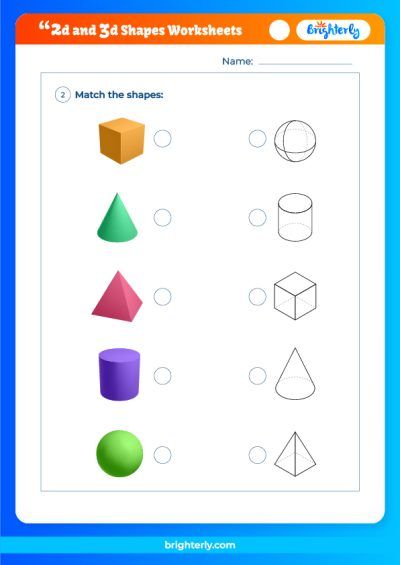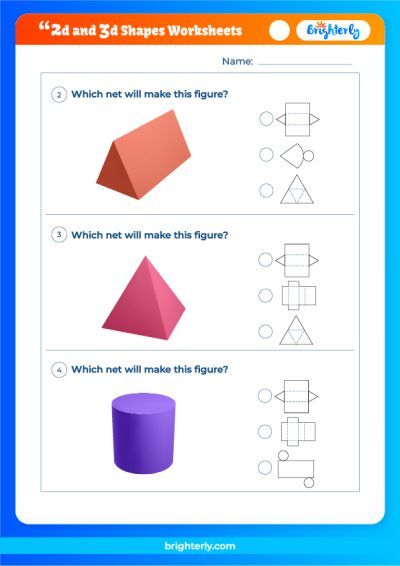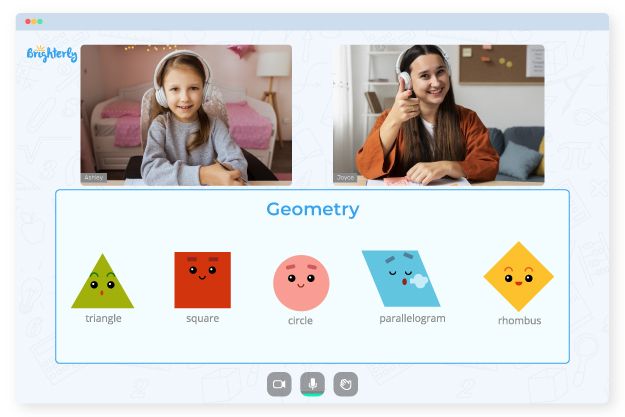2D (Two Dimensional) Shapes
Updated on January 9, 2024
Discover the fascinating world of 2D shapes with Brighterly! Our unique approach to teaching geometry helps children easily grasp the concepts of two-dimensional shapes while having fun. We focus on making learning enjoyable and interactive so that kids are excited to explore the various shapes, properties, and calculations associated with these essential mathematical figures.
What are 2D Shapes?
2D shapes are flat, two-dimensional objects that have length and width. They are also known as plane figures or plane shapes because they lie entirely in a single plane. Children are often introduced to 2D shapes in their early years of education, and understanding these shapes is crucial for building a strong foundation in geometry and other branches of mathematics.
In this engaging and informative post, we will delve into the captivating realm of 2D shapes. By exploring their unique properties and common examples, your child will not only gain a solid understanding of geometric concepts but also develop an appreciation for the beauty and relevance of mathematics in everyday life.
2D Shapes Names and Properties
There are several basic 2D shapes, each with its own unique properties. Let’s dive into each of them:
Circle
A circle is a beautifully symmetrical, round, closed figure in which all points are equidistant from a central point called the center. This equidistance is referred to as the radius, which serves as a crucial measurement in circle-related calculations. One fascinating aspect of circles is their circumference – the distance that encompasses the entire shape. The formula to determine the circumference is 2πr, where “r” represents the radius. In the world of geometry, circles hold a unique position due to their smooth, continuous curve and infinite lines of symmetry.
Triangles
Triangles are intriguing polygons with three sides and three angles that come together to create various shapes. The fascinating world of triangles offers diverse classifications based on their sides (equilateral, isosceles, or scalene) and angles (acute, right, or obtuse). Equilateral triangles boast three equal sides, while isosceles triangles have two equal sides. In contrast, scalene triangles exhibit no equal sides. Triangles play a pivotal role in geometry as the simplest polygons and can be combined to create more complex shapes.
Squares
The square is an elegant four-sided polygon characterized by equal sides and four right angles (90 degrees). It holds a special place in geometry as it is both a rectangle and a rhombus. The area of a square, a measure of the space it occupies, is determined by squaring the length of one side (side^2). Squares exhibit remarkable symmetry, with four lines of symmetry dividing them into equal halves. Their simplicity and elegance make them a fundamental shape in geometry and design.
Rectangles
Rectangles are versatile four-sided polygons featuring opposite sides of equal length and four right angles. The area of a rectangle is calculated by multiplying its length and width, providing a simple yet effective measure of the space it occupies. Rectangles are unique due to their perfect balance of symmetry and flexibility. They have two lines of symmetry, making them less symmetrical than squares but more adaptable to various real-world applications, such as in architecture and design.
Pentagons
Pentagons are fascinating polygons with five sides and five angles. They can be regular, exhibiting equal sides and angles, or irregular, with varying sides and angles. Pentagons play a significant role in both geometry and nature, with the regular pentagon serving as the foundation for the dodecahedron, a Platonic solid. These five-sided wonders captivate the imagination and challenge the intellect, as they are the first polygons that cannot be regularly tessellated on a plane.
Octagons
Octagons are striking polygons with eight sides and eight angles. They can be regular, characterized by equal sides and angles, or irregular, with sides and angles of different lengths and measures. Octagons possess intriguing properties and are often seen in everyday life, such as in stop signs and architecture. With their unique shape and a balance between symmetry and complexity, octagons offer a captivating subject for exploration in the world of 2D shapes.
Unveiling the Secrets of 2D Shapes Properties
Every 2D shape possesses its own unique properties, such as the number of sides, angles, and their measures. Some shapes also display lines of symmetry, which bisect the shape into two identical halves. Understanding the properties of each 2D shape is vital to mastering geometry and appreciating the inherent beauty and order in mathematics.
To deepen your understanding of 2D shapes, we recommend exploring the math worksheets offered by Brighterly. These worksheets have been designed to assist in learning and consolidating your knowledge on this topic.
Area and Perimeter of 2D Shapes
The area of a 2D shape represents the amount of space it occupies, while the perimeter refers to the total length of its boundaries. To excel in geometry, children need to learn and practice various formulas for calculating the area and perimeter of different 2D shapes. For instance, the area of a square is calculated by squaring the length of one side, while the perimeter is determined by multiplying the side length by 4. By mastering these calculations, children can enhance their problem-solving skills and develop a deeper understanding of geometric concepts.
Difference Between 2D and 3D Shapes
A key distinction between 2D and 3D shapes lies in their dimensionality. While 2D shapes are flat and possess only length and width, 3D shapes have length, width, and height (or depth), giving them a more substantial presence in the physical world. Examples of 3D shapes include cubes, spheres, and cylinders, which can be observed in everyday objects like dice, basketballs, and soda cans. Gaining an understanding of the differences between 2D and 3D shapes is vital for children to broaden their perspective on geometry and the world around them.
Solved Examples
To assist your child in grasping the concepts of 2D shapes more effectively, we have provided a variety of solved examples. These examples cover diverse topics, such as calculating area and perimeter, identifying shapes based on properties, and solving geometric problems. By studying these examples, children can hone their skills and gain the confidence to tackle even more challenging problems.
Problems on Two Dimensional Shapes
The key to mastering 2D shapes is consistent practice. Encourage your child to work on a range of practice problems to improve their understanding of 2D shapes and their properties. These problems encompass various levels of difficulty, allowing children to progressively build their skills and confidence in geometry. As they work through the problems, your child will develop a strong foundation in 2D shapes that will serve them well in their mathematical journey.
Conclusion
Embracing the world of 2D shapes is an essential step in a child’s mathematical journey. Through a comprehensive understanding of these shapes, their properties, and the ability to calculate their area and perimeter, children can establish a robust foundation in geometry. This knowledge will prove invaluable in various aspects of life, from tackling everyday problems to pursuing advanced studies in mathematics or related fields.
At Brighterly, we are committed to making learning an enjoyable and engaging experience for children. We believe that by fostering a love for mathematics, we are empowering the next generation of problem solvers, critical thinkers, and innovative leaders. Explore our website for a wealth of resources, interactive activities, and captivating games designed to help your child excel in mathematics and beyond. With Brighterly by their side, your child’s future will undoubtedly shine Brighterly!
Frequently Asked Questions on Two Dimensional Shapes
What are some real-life examples of 2D shapes?
-
- Circles: coins, clock faces, and wheels
- Triangles: yield signs, pizza slices, and the Eiffel Tower
- Squares: chessboards, tiles, and windows
- Rectangles: doors, bricks, and smartphones
- Pentagons: the Pentagon building, home plate in baseball, and traffic signs
- Octagons: stop signs, and the shape of some tables
How can I help my child learn about 2D shapes?
-
- Use everyday objects to illustrate the different shapes.
- Encourage them to practice drawing the shapes.
- Play games and engage in activities that involve recognizing and categorizing shapes.
- Provide them with practice problems and puzzles involving 2D shapes.
Are there other types of polygons besides the ones mentioned in this article?
Yes, there are numerous other types of polygons, such as hexagons (6 sides), heptagons (7 sides), nonagons (9 sides), and decagons (10 sides). These shapes can also be regular (all sides and angles equal) or irregular (sides and angles not equal).
Information Sources
The information in this article was gathered from the following sources:






